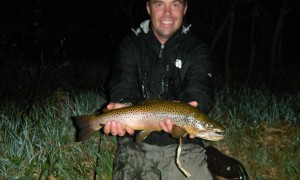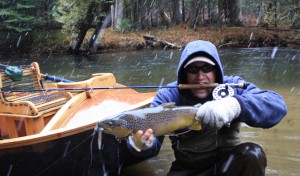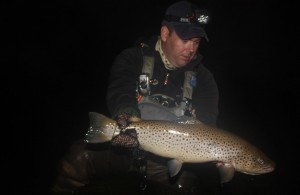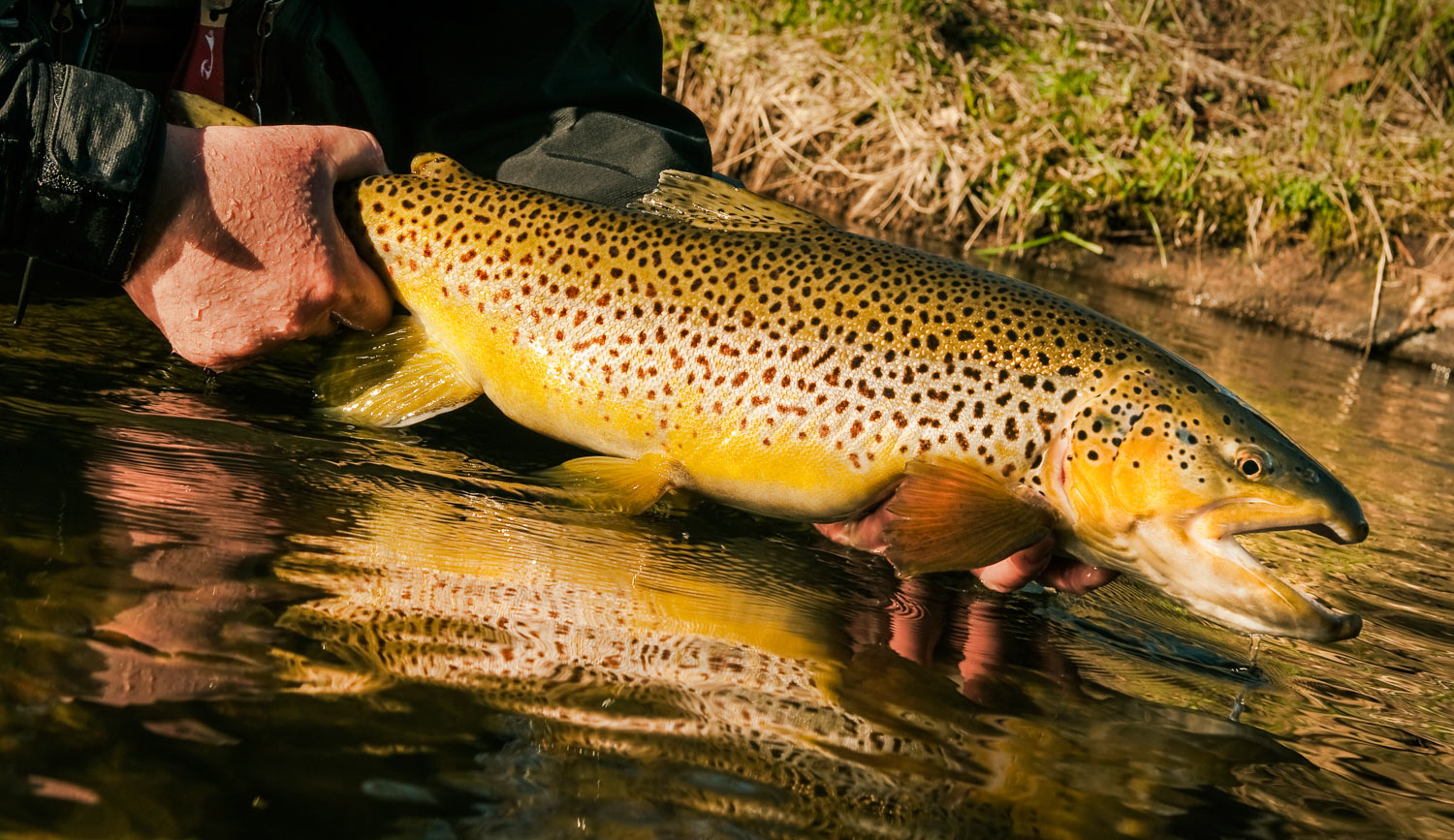by Jason Tucker
I’ll never forget my first brown trout over 20 inches.
It was about 1:30 am after a very long float down a tiny stream. It had been a slow night with only a couple half-hearted tugs on our mouse imitations. We got down to one of the last holes with a feeding run above it and parked the boat. On my first cast the water erupted with a loud take but the fish missed. I placed my next cast where the fish had hit, made a couple of strips and let it coast. The strike was unmistakable, and I waited that extra half beat until I felt the fish before setting the hook. After a vigorous fight on my 5 weight we slid a 21-inch hook-jawed male into the net, took a couple of quick pics and let him go. It was a magical moment to be sure.
Since then I’ve caught several dozen fish over 20 inches, my biggest being over 28 inches long and about ten pounds. I’ve caught them at night and during the day by a variety of methods. That first 20+ inch fish was like flipping a switch for me. Which is why I’m surprised how often I still hear even experienced anglers express that they would love to catch a brown over 20 inches. Here’s a few tips to make that dream a reality.
Know thy Trout
 Brown trout have the potential to get big– really big. The world record is over forty pounds, and in lakes and reservoirs they commonly average ten to twenty pounds. In good water the only limiting factors are mortality and food abundance. River environments tend to limit brown trout growth more than lakes, but most streams will still hold good numbers of browns over twenty inches.
Brown trout have the potential to get big– really big. The world record is over forty pounds, and in lakes and reservoirs they commonly average ten to twenty pounds. In good water the only limiting factors are mortality and food abundance. River environments tend to limit brown trout growth more than lakes, but most streams will still hold good numbers of browns over twenty inches.
While young trout mostly feed on insects and larvae (think mayflies and nymphs) as they reach that magical twenty-inch mark, insects no longer serve to curb the appetite. At this point they become largely piscivorous, or fish eaters, according to researchers. While this is true, brown trout make the most of any opportunity, and this includes seasonal abundance brought about by the larger fly hatches. In midsummer they shift their diets to include mice and frogs eaten at night.
Another factor to consider is the changed social/dominance status that increasing size lends to them. Small trout have to fend for themselves as best they can, while large trout will always take up the best, most secure lies in a system, and defend them from other fish. This is often deep under a cut bank, or at the bottom of a log jam in a deep hole. As they grow larger they also prefer to feed after dark as long as available food sources permit this. You end up with a situation where smaller fish are forced to feed during the day and in positions easily fished to, while the largest fish feed only at night or in spots impossible to reach.
Don’t despair. Under the right circumstances those big fish will come out and feed. A prime example is during the spring Hendrickson hatch. They’re one of the first sizable insects to hatch in spring, and big browns can’t seem to resist them even though they hatch at mid-day. It’s a prime opportunity to get your picture taken with Mr. Big during the daytime. Here are three more ways to do that.
Embrace Streamers
 As mentioned, big browns are highly piscivorous, with minnows, sculpins and smaller trout providing the most consistent and sizable meal source in any given stream. You can also add crayfish to that mix. Do yourself a favor and buy or borrow the book Modern Streamers for Trophy Trout by Kelly Galloup and Bob Linsenman. It started the whole modern streamer revolution, and is still gospel on the subject. Prime months for streamer fishing are April/May and September/October, or when water temps are around 55 degrees. On the right day and conditions, big browns will eat all day long, giving multiple opportunities for a photo op and a ton of excitement along the way.
As mentioned, big browns are highly piscivorous, with minnows, sculpins and smaller trout providing the most consistent and sizable meal source in any given stream. You can also add crayfish to that mix. Do yourself a favor and buy or borrow the book Modern Streamers for Trophy Trout by Kelly Galloup and Bob Linsenman. It started the whole modern streamer revolution, and is still gospel on the subject. Prime months for streamer fishing are April/May and September/October, or when water temps are around 55 degrees. On the right day and conditions, big browns will eat all day long, giving multiple opportunities for a photo op and a ton of excitement along the way.
Fish the Major Hatches
Big browns are highly opportunistic and readily switch feeding behaviors as different food sources become prevalent. This includes major fly hatches. In the upper Midwest these include the Hendrickson, Isonychia, Gray Drake, brown Drake, and Hexagenia hatches. Hit one of these hatches and you have a great chance at a nice brown. All but the Hexagenia hatches offer at least some opportunities during daylight.
Don’t Be Afraid Of The Dark
 That’s right– we’re talking mousing. Actually streamers and a couple of other strategies work well at night too, but most of the time you’re trying to imitate a mouse. A whole book could be written on the subject, and one should be, but night time fishing big hairy flies is the main event. In midsummer, brown trout start to zero in on mice falling in or swimming across the river. They are also targeting frogs. The point is moot as to which they are really after as both behave in similar manner and both get regularly eaten. You just need a big fly that leaves a tell-tale wake across the surface. At night those big browns leave the holes and snags and head out on the prowl. We’ve hooked up in as little as six inches of water on inside bends. While it’s not a slam dunk, it is the most consistent pattern throughout the warm months, and works well on those late evenings and nights when the fly hatch you were after didn’t happen. I’ve even targeted and landed brown trout during the Hex hatch that were in places impossible to reach with a dead drifted Hex fly by swinging a mouse in front of the feeding fish.
That’s right– we’re talking mousing. Actually streamers and a couple of other strategies work well at night too, but most of the time you’re trying to imitate a mouse. A whole book could be written on the subject, and one should be, but night time fishing big hairy flies is the main event. In midsummer, brown trout start to zero in on mice falling in or swimming across the river. They are also targeting frogs. The point is moot as to which they are really after as both behave in similar manner and both get regularly eaten. You just need a big fly that leaves a tell-tale wake across the surface. At night those big browns leave the holes and snags and head out on the prowl. We’ve hooked up in as little as six inches of water on inside bends. While it’s not a slam dunk, it is the most consistent pattern throughout the warm months, and works well on those late evenings and nights when the fly hatch you were after didn’t happen. I’ve even targeted and landed brown trout during the Hex hatch that were in places impossible to reach with a dead drifted Hex fly by swinging a mouse in front of the feeding fish.
Obviously I’m just skimming the surface of three very different techniques, but it gives you an idea of where to start in the quest for big fish. Big browns are a different fish from smaller browns, and it’s not enough to show up on your summer vacation and throw a size 12 Adams at mid-day. Study up on these three methods, put them to work and start catching some BIG browns.
Jason writes the fine blog Fontinalis Rising
Jason Tucker
Gink & Gasoline www.ginkandgasoline.com hookups@ginkandgasoline.com Sign Up For Our Weekly Newsletter!

I want everyone who reads this to be afraid of the dark. I don’t want anybody to discover how productive a July evening can be. It’s seems like Brown’s have gone nocturnal here in Michigan. Stripping mice and big streamers – yes your going to loose some gear in the brush, but rewards are measured in pounds and feet. The Hex hatch is a whole different ball game, tossing hex spinners at your feet in a frenzy of something that sounds like baseballs being gently tossed in the water.
Don’t forget – be afraid of the dark. Big bad things lurk in the water!!!
I am not afraid of the dark(sometimes maybe) fished saltwater around lighted docks caught trout) but what the heck do you do with no moon? No light? Enlighten me, please!
Even under a new Moon there is enough background light emitted from the night sky to make seeing reasonably easy. The darkest nights of all are those with low, thick cloud cover.
It’s my belief that some certain states with regs prohibiting fishing in darkness hold record browns in their deepest stream holes. I’ve seen them, I’ve tried to target them in day, and one time, at twilight with the conditions just right, I got one to hit a mouse. I was taken out 150 feet and the hook tore out. Felt like I had hooked a seal. True stuff in the article above. Great article
Good Article! Last year I picked up my personal Best Brown out of a small trout stream. It was late spring, small stream tactics after a very light rainfall.
Pingback: Tippets: Carp Throw Down, Catching Trophy Browns, Tying the Reaper Midge | MidCurrent